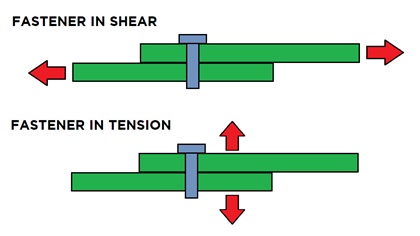Aircraft Maintenance: Understanding fasteners
Shear, tension, and the hardware that holds it all together
Maintaining an airworthy (and safe) aircraft is a team effort involving the owner, the pilot, and the mechanic. The mechanic may be the most experienced member of the team, but a mechanic only sees the aircraft during routine inspections or maintenance. For all of the flight hours in between, it’s the responsibility of those who own and fly the aircraft to do the preflight inspections and preventive maintenance tasks that keep the aircraft airworthy. So, it is important to understand some basic concepts of “how things work” on your aircraft, to help you spot trouble before it progresses and take appropriate action.
Let’s focus on one of the simplest, yet most important things that you can inspect during any preflight: fasteners. More specifically, the removable fasteners that hold everything together from interior trim to engine cylinders. Aside from the basic riveted, welded, or bonded structure of an aircraft, nearly every component is assembled using fasteners. These include screws, bolts, washers, and nuts, among others.
In other situations, the goal may be to hold parts together and resist forces pulling them apart in the same axis as the screw or bolt. This is known as tension. Think about your engine cylinders. The nuts around the base of the cylinder hold it tightly to the crankcase, resisting the forces created by the combustion process and keeping the cylinder from flying off the engine.

Understanding the primary function of a bolt can help you understand how to inspect it during your preflight, as well as when and how to replace (or re-secure it) if you need to. For example, when a bolt is used in shear, the fit between the bolt and its hole is extremely important. It should be a relatively tight fit so that there is little movement once the bolt is installed. If the fit is too loose, you should inspect the bolt for wear and possibly replace it. If the problem is caused by wear in the hole, your mechanic may need to repair it by oversizing the hole and bolt, or replacing the components. In some cases, close-tolerance bolts, or bolts of specialized materials, may be used. The forces at work in these joints are literally working to “shear” the bolt in half. So you want to make sure that the bolt has not been bent or damaged in any way. Simply over-tightening a nut on a loose bolt in shear will not effectively keep the two parts from sliding against each other (and may even cause more trouble in the future).
When a bolt is used primarily in tension, the pressure that it exerts on the components that it is holding together is more critical than the fit between the bolt and the hole. The bolt is stressed lengthwise and it’s important to ensure that it has not been overstressed (by over-torquing) and that the threads on both the bolt and nut are in excellent condition. In these situations, it is critical to visually verify that the fastener hasn’t loosened during your preflight. This is easy to do if “torque seal” was applied to the fastener after installation. Torque seal is basically a glob of paint that cracks and falls apart if the bolt or nut rotates. It provides a visual clue during preflight that all of these points are secure. Here are a few tips for dealing with fasteners in both situations.
Fasteners primarily used in shear:
- Look for signs of relative movement between the parts (sliding or fretting).
- Examine bolts for wear (getting thinner) and holes for elongation (getting wider).
- Ensure that you are using the correct hardware (some situations require special close-tolerance bolts for a tight fit).
- Never solve a wear problem by over-tightening.
Fasteners primarily used in tension:
- Always use a calibrated torque wrench.
- Apply torque seal to every fastener so that loosening can be visually detected.
- If you suspect a bolt has been over-torqued, replace it (and the nut).
- Always use the fasteners called for in the maintenance manual.
This is a gross oversimplification of the complex role of fasteners. Most fasteners serve multiple purposes and have a variety of forces at work on them. However, understanding the basic concepts of shear and tension will help you understand why some bolts are designed to be attached fairly lightly with only a cotter pin, while others utilize very specific torques and special nuts. With that in mind, I will leave you with this challenge for your next preflight inspection: Find 10 different fasteners on your aircraft and ask yourself, “Is it primarily in shear or tension?” If you’re not sure, ask your A&P and get a free lesson in shear and tension.
Until next time, I hope you and your families remain safe and healthy and wish you blue skies.


